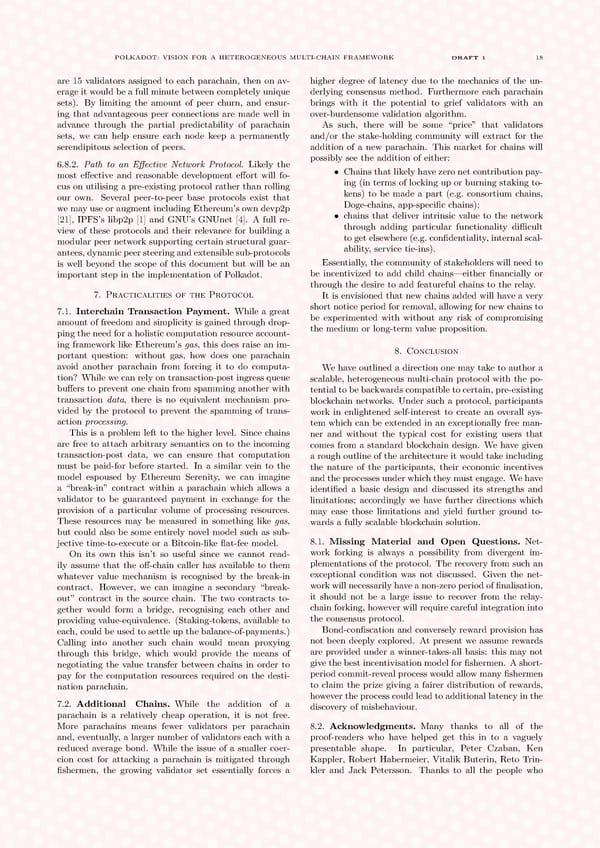POLKADOT: VISION FOR A HETEROGENEOUS MULTI-CHAIN FRAMEWORK DRAFT 1 18 are 15 validators assigned to each parachain, then on av- higher degree of latency due to the mechanics of the un- erage it would be a full minute between completely unique derlying consensus method. Furthermore each parachain sets). By limiting the amount of peer churn, and ensur- brings with it the potential to grief validators with an ing that advantageous peer connections are made well in over-burdensome validation algorithm. advance through the partial predictability of parachain As such, there will be some “price” that validators sets, we can help ensure each node keep a permanently and/or the stake-holding community will extract for the serendipitous selection of peers. addition of a new parachain. This market for chains will 6.8.2. Path to an Effective Network Protocol. Likely the possibly see the addition of either: most effective and reasonable development effort will fo- • Chains that likely have zero net contribution pay- cus on utilising a pre-existing protocol rather than rolling ing (in terms of locking up or burning staking to- our own. Several peer-to-peer base protocols exist that kens) to be made a part (e.g. consortium chains, wemayuseoraugmentincludingEthereum’s own devp2p Doge-chains, app-specific chains); [21], IPFS’s libp2p [1] and GNU’s GNUnet [4]. A full re- • chains that deliver intrinsic value to the network view of these protocols and their relevance for building a through adding particular functionality difficult modular peer network supporting certain structural guar- to get elsewhere (e.g. confidentiality, internal scal- antees, dynamicpeersteeringandextensiblesub-protocols ability, service tie-ins). is well beyond the scope of this document but will be an Essentially, the community of stakeholders will need to important step in the implementation of Polkadot. be incentivized to add child chains—either financially or through the desire to add featureful chains to the relay. 7. Practicalities of the Protocol It is envisioned that new chains added will have a very 7.1. Interchain Transaction Payment. While a great short notice period for removal, allowing for new chains to amount of freedom and simplicity is gained through drop- be experimented with without any risk of compromising ping the need for a holistic computation resource account- the medium or long-term value proposition. ing framework like Ethereum’s gas, this does raise an im- 8. Conclusion portant question: without gas, how does one parachain avoid another parachain from forcing it to do computa- Wehave outlined a direction one may take to author a tion? While we can rely on transaction-post ingress queue scalable, heterogeneous multi-chain protocol with the po- buffers to prevent one chain from spamming another with tential to be backwards compatible to certain, pre-existing transaction data, there is no equivalent mechanism pro- blockchain networks. Under such a protocol, participants vided by the protocol to prevent the spamming of trans- work in enlightened self-interest to create an overall sys- action processing. tem which can be extended in an exceptionally free man- This is a problem left to the higher level. Since chains ner and without the typical cost for existing users that are free to attach arbitrary semantics on to the incoming comes from a standard blockchain design. We have given transaction-post data, we can ensure that computation a rough outline of the architecture it would take including must be paid-for before started. In a similar vein to the the nature of the participants, their economic incentives model espoused by Ethereum Serenity, we can imagine andtheprocessesunderwhichtheymustengage. Wehave a “break-in” contract within a parachain which allows a identified a basic design and discussed its strengths and validator to be guaranteed payment in exchange for the limitations; accordingly we have further directions which provision of a particular volume of processing resources. may ease those limitations and yield further ground to- These resources may be measured in something like gas, wards a fully scalable blockchain solution. but could also be some entirely novel model such as sub- jective time-to-execute or a Bitcoin-like flat-fee model. 8.1. Missing Material and Open Questions. Net- On its own this isn’t so useful since we cannot read- work forking is always a possibility from divergent im- ily assume that the off-chain caller has available to them plementations of the protocol. The recovery from such an whatever value mechanism is recognised by the break-in exceptional condition was not discussed. Given the net- contract. However, we can imagine a secondary “break- workwillnecessarily have a non-zero period of finalisation, out” contract in the source chain. The two contracts to- it should not be a large issue to recover from the relay- gether would form a bridge, recognising each other and chain forking, however will require careful integration into providing value-equivalence. (Staking-tokens, available to the consensus protocol. each, could be used to settle up the balance-of-payments.) Bond-confiscation and conversely reward provision has Calling into another such chain would mean proxying not been deeply explored. At present we assume rewards through this bridge, which would provide the means of are provided under a winner-takes-all basis: this may not negotiating the value transfer between chains in order to give the best incentivisation model for fishermen. A short- pay for the computation resources required on the desti- period commit-reveal process would allow many fishermen nation parachain. to claim the prize giving a fairer distribution of rewards, however the process could lead to additional latency in the 7.2. Additional Chains. While the addition of a discovery of misbehaviour. parachain is a relatively cheap operation, it is not free. More parachains means fewer validators per parachain 8.2. Acknowledgments. Many thanks to all of the and, eventually, a larger number of validators each with a proof-readers who have helped get this in to a vaguely reduced average bond. While the issue of a smaller coer- presentable shape. In particular, Peter Czaban, Ken cion cost for attacking a parachain is mitigated through Kappler, Robert Habermeier, Vitalik Buterin, Reto Trin- fishermen, the growing validator set essentially forces a kler and Jack Petersson. Thanks to all the people who
 POLKADOT Page 18 Page 20
POLKADOT Page 18 Page 20